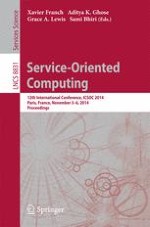This book constitutes the refereed conference proceedings of the 12th International Conference on Service-Oriented Computing, ICSOC 2014, held in Paris, France, in November 2014. The 25 full and 26 short papers presented were carefully reviewed and selected from 180 submissions. The papers are organized in topical sections on business process management; service composition and discovery; service design, description and evolution; cloud and business service management; ensuring composition properties; quality of service; semantic web services; service management; cloud service management; business service management; trust; service design and description.
